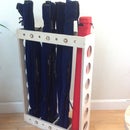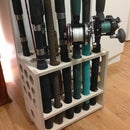Introduction: Convert a Dresser Drawer to an Electonics Bay With a Drop-down Door
Here is an example of converting a drawer in an existing dresser into an electonics bay. You don't have to choose between a dresser and an entertainment center!
The drawer face is reused for a door with a drop-down hinge. When closed, the appearance is the same as a drawer. When opened, the door drops down out of the way.
I also have an instructable for building an a dresser using this bay: https://www.instructables.com/id/Minimalist-Style-Dresser-with-Electronics-Bay/
Step 1: Tools and Materials
Tools:
- Basic tools for cutting wood in straight line (e.g. table saw)
- Hand drill and bits (standard drill bits plus countersink)
- Basic tools for cutting and shaping aluminum (you can do this with a hacksaw and a file in a pinch)
- Screwdriver
- 10 mm wrench or socket
- Pocket screw kit (optional) pocket jig, drill and driver bit.
Materials:
Note that the actual dimensions and amounts of materials will vary based on the size of your dresser.
- 1 Dresser,
- 3/4 inch plywood, dimensions to match the dresser drawer bay (this will be the shelf for your electronics).
wood
- 1 1/2 x 1/2 wood strip approximately 2 foot length ( I used plywood)
- 1/8 inch aluminium angle iron, 3/4 x1/2 inch - approximately 3 foot length
- wood screws
- 2 6x32 Phillips machine screws -3/8 inch length (flat head suitable for countersink)
- 2 6x32 locking nuts
- 2 nylon bushings 6 mm inside dimension (I used 1/4 nylon spaces from my local computer parts superstore- much cheaper than bushings!)
Step 2: Planning
Thee are two basic planning steps.
1. Converting the drawer.
If you are careful and the dresser design is cooperative it should be possible to design a conversion that will allow you to easily revert back to a drawer in the future.
How to remove the drawer face- Many dressers have drawer faces that can be detached from the drawer box. You may have to remove the handle first.
Convert the drawer box or add a shelf- you can remove the front from the drawer box and reinforce the bottom to create a slide-out bay, or you can remove the drawer and slides entirely, and insert a shelf that is flush with the bottom of the rail. I personally prefer the shelf method, as it is stronger and provides more space.
2. Hinge length and location. The hinge has to support the closed position, and be able to drop the drawer face completely below the shelf . If the drawer face does not drop low enough, it will be hard to insert your electronics, and it may block the signal from your wireless remote.
Determine the length and pivot points for the hinges on the dresser frame and the door. You can model this with a stiff piece of paper and a thumb tack. For my dresser, the best frame pivot location was about one inch from the front, ad about 1/3 of the distance from the shelf to to the top of the opening. I made the length as long as as possible, leaving just enough room for the hinge to clear the top of the opening.
Check out the photo for this step to see what the hinges looks like in the closed and open position.
Step 3: Convert Drawer
Remove the drawer face. Attach some small blocks of the 1/2x 1 1/2 wood to the bottom inside of the face. These will support the face in the frame when closed.
If the drawer face is not thick enough to support the hinges, attach some wood to the inside top of the face. The first photo shows both the top and bottom blocks installed (note the face is flipped up, so the bottom is facing up).
If adding a shelf, measure and cut the 3/4 plywood to fit flush with the rail. Drill underside with pocket screw jig. Apply any desired finish to top of shelf. Attach shelf to dresser with pocket screws.
Drill some access/ventilation holes in the back of the dresser above the shelf.
Step 4: Build Hinges
There are two double-pivot hinges.
The arms are interchangeable. the ends are drilled on the wide side for for attaching to the dresser frame, and the narrow side for attaching to the face.
- Cut two arms and four ends from the aluminum stock.
- Clamp the end pieces to the arms in the closed position, and drill a small pilot hole for the pivots. In my design the pivots are located at the top of the end pieces for the drawer faces to support the greatest possible arm length.
- Drill out the holes in the arms to the outer diameter of the bushing. press in the bushings, filing them to be flush. File the ends round and remove any additional material preventing the hinge from opening/closing.
- Drill out the pilot holes in the end pieces to the size of the screws. countersink the hole so that the screws fit flush. Drill and countersink holes for screws to attach end pieces to frame.
- Attach the arms to the end pieces with the screws and nuts.
Step 5: Installation
Attach the hinges to the dresser frame with wood screws
Temporarily lock the the hinges in the nearly closed (up) position. This can be accomplished with some scraps of wood and masking tape.
Apply a drop of temporary quick drying glue to the hinge end where it attaches to the drawer face ( a glue gun is nice, but a tiny dab of quick drying CA glue can also be used). Before the glue hardens, press the face against the hinges. The wood blocks on the bottom of the face should be resting on the shelf.
Once the glue hardens, carefully open the door, and mark the locations for the hinge screw holes in the face.
Screw the hinges into the face.
Step 6: Test Drive- and Fine Tune.
The drawer face is now a door that can be opened by swinging the base up and then lowering until it the arms rest on the shelf and the door rests on the handle of the drawer below.
I used some furniture felt strips to protect any abrasion points.
If the hinge system is too wobbly for your taste, a crossbar from the aluminum angle iron material with stiffen things up. Attach the crossbar to the arms as close to the door end pieces as possible.
Step 7: Improvements
While the hinges have held up for several months (since the face is always resting on the blocks when closed, or the arms when open, the pivots do not take much stress), the system could be improved by using a significantly larger diameter bushing for the pivot. I am playing around with a design that uses a 1 inch pivot, and perhaps an adjustable arm length, and would suggest you consider this as well.













